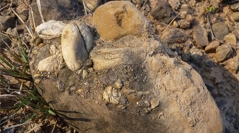

 Comptes Rendus Palevol
15 (3-4) - Pages 393-406
Comptes Rendus Palevol
15 (3-4) - Pages 393-406Since 2008, the Indo-French research program ‘Siwaliks’ has been prospecting in the Late Pliocene formations of the Chandigarh anticline in the Northwest of India (Siwalik Frontal Range, Himalayan foothills). More than 200 quartzite tools and 1500 terrestrial vertebrate fossils have been collected from a Pliocene continental formation near the village of Masol. Several fossils show exceptional cut marks. A complete geological investigation of this area was performed in order to reconstruct the paleoenvironment. The geological sequences of the three major paleonto-archeological localities, Masol 1, Masol 6 and Masol 13, were studied. Silt and sandstone samples of the Quranwala fossiliferous area were collected to correlate the stratigraphy among the three localities and to understand the origins of the sediments. Three different techniques were used to analyze the sediments: a granulometric approach, X-ray diffraction and an analysis of heavy minerals. The sediment analysis demonstrates the relationship between the sample collected in Masol and the dismantling of the Higher as well as of the Lesser Himalaya. During the Late Pliocene, Masol was a floodplain with rich continental and freshwater fauna. The rivers were relatively calm, as indicated by the presence of apatite. Despite this, the quasi-simultaneous accumulations of quartzite cobbles and clay, as well as the presence of carcasses of small and large herbivores, suggest sudden climate variations probably due to the monsoon.
Siwalik Frontal Range, Late Pliocene, Masol Formation, Himalayan metamorphism, Sub-Himalayan floodplain, Fluvial deposits